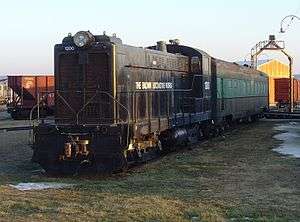Baldwin S-12
| Baldwin S-12 | |||||||||||||||||||||||||||||||||||||||||||
|---|---|---|---|---|---|---|---|---|---|---|---|---|---|---|---|---|---|---|---|---|---|---|---|---|---|---|---|---|---|---|---|---|---|---|---|---|---|---|---|---|---|---|---|
|
A preserved S-12 at the Railroad Museum of Pennsylvania. | |||||||||||||||||||||||||||||||||||||||||||
| |||||||||||||||||||||||||||||||||||||||||||
| |||||||||||||||||||||||||||||||||||||||||||
| |||||||||||||||||||||||||||||||||||||||||||
| |||||||||||||||||||||||||||||||||||||||||||
| Balwin DS-4-4-660 / DS-4-4-1000 | |||||||||||||||||||||||||||||||||||||||||||||||
|---|---|---|---|---|---|---|---|---|---|---|---|---|---|---|---|---|---|---|---|---|---|---|---|---|---|---|---|---|---|---|---|---|---|---|---|---|---|---|---|---|---|---|---|---|---|---|---|
| |||||||||||||||||||||||||||||||||||||||||||||||
| |||||||||||||||||||||||||||||||||||||||||||||||
| |||||||||||||||||||||||||||||||||||||||||||||||
| |||||||||||||||||||||||||||||||||||||||||||||||
The Baldwin S-12 was a 1,200-horsepower (890 kW) diesel-electric locomotive intended for use in yard switching. Utilizing a turbocharged 6-cylinder version of the powerful 606A diesel prime mover, S-12s were known for their "lugging" power, despite being temperamental. Like most Baldwin switchers, the S-12 had AAR Type-A switcher trucks in a B-B wheel arrangement. 451 units were built between 1951 and 1956, when Baldwin left the locomotive market.
Previous models
Baldwin made a number of switchers with similar dimensions and body styles. The first body style, used in VO models, had a slightly pointed nose with a round radiator opening. The second and third body style, almost indistinguishable and used interchangeably, had a flat nose and rectangular radiator opening. Various exhaust stacks were used, and are not an effective spotting feature, except that turbocharged models always had one large stack offset to the side.
The VO-660 was built between April 1939 and May 1946. It was powered by a naturally aspirated six cylinder engine rated at 600-horsepower (450 kW). 142 were built. Baldwin replaced the VO-660 with the model DS-4-4-660 in 1946.
The VO-1000 was built between January 1939 and December 1946. It was powered by a naturally aspirated eight cylinder engine rated at 1,000-horsepower (750 kW). Some had the Batz truck originally developed by the Atchison, Topeka and Santa Fe Railway as a leading truck for steam locomotives. 548 VO-1000s were built.
The DS-4-4-660 was built between 1946 and 1949. It replaced the 600-horsepower (450 kW) VO-660 as the low power companion to the DS-4-4-1000 models. 139 were built.
The DS-4-4-1000 was a 1,000-horsepower (750 kW) model built between 1946 and 1951. The first units (56 locomotives) were powered by an 8-cylinder normally aspirated prime mover, but from 1948 a change was made to a 6-cylinder turbocharged engine. A total of 502 were built.
Original buyers
Surviving units
At least six intact examples of the S-12 are known to survive at railroad museums. SMS Lines operates S-12 #301 at the Penn Warner industrial park at Morrisville, Pennsylvania. One unit that was converted from a Baldwin DS-4-4-1000 is in service on the Whitewater Valley Railroad.
Only three intact examples of the VO-660 are known to survive, one of which was sold by the Altoona Railroaders Memorial Museum to SMS Lines to be repaired and put back into operation. The others are Pickens Railway #2, built in 1946, and Wyandotte Terminal 103, at the Illinois Railway Museum
There are at least eight intact examples of the VO-1000 that are known to survive, all of which are owned by museums or historical societies.
References
- Dorin, Patrick C. (1972). Chicago and North Western Power. Burbank, California: Superior Publishing. pp. 158, 161–163. ISBN 0-87564-715-4.
- Pinkpank, Jerry A (1973). The Second Diesel Spotter’s Guide. Kalmbach Books. pp. 282, 287–291. ISBN 0-89024-026-4. LCCN 66-22894.
External links
| Wikimedia Commons has media related to Baldwin S-12 locomotives. |
